
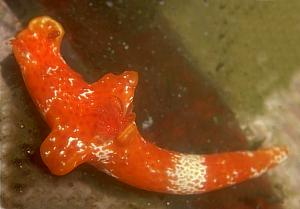
Ceratosoma gracillimum
Semper in Bergh, 1876
Order: NUDIBRANCHIA
Suborder: DORIDINA
Superfamily: EUDORIDOIDEA
Family: Chromodorididae
DISTRIBUTION
Published records from Great Barrier Reef, Philippines, Vietnam. Probably tropical Western Pacific.
PHOTO
UPPER: Channel between Wistari Reef and Heron Id, Queensland, May 1981. 43mm long alive. Photo: Bill Rudman.
LOWER: Heron Is, Queensland, December 1981. 65mm long alive. Photo: G. Avern.
Ceratosoma gracillimum can be distinguished externally by the complete absence of the mantle edge between the head and the well-developed lateral lobes on each side, just in front of the gills. Can grow up to about 12cm in length.
References:
• Rudman, W.B. (1984) The Chromodorididae (Opisthobranchia: Mollusca) of the Indo-West Pacific: a review of the genera. Zoological Journal of the Linnean Society, 81: 115-273.
• Rudman, W.B. (1988) The Chromodorididae (Opisthobranchia: Mollusca) of the Indo-West Pacific: the genus Ceratosoma J.E. Gray. Zoological Journal of the Linnean Society, 93(2): 133-185
Rudman, W.B., 2000 (September 17) Ceratosoma gracillimum Semper in Bergh, 1876. [In] Sea Slug Forum. Australian Museum, Sydney. Available from http://www.seaslugforum.net/find/ceragrac
Related messages
Ceratosoma gracillimum from Alor, Indonesia
April 24, 2008
From: Francois Zylberman
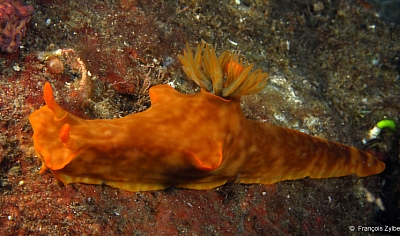
Hi Bill,
I am sure that it is a Ceratosoma, but I do not find any with the same color. Which is this?
Locality: Alor islands, Pantar strait, 10m, Indonesia, Indo pacific, 28 may 2007, Sand and rocks. Length: 100 to 120mm. Photographer: Francois Zylberman.
Thanks
Francois
francois@geodia.com
Zylberman, F., 2008 (Apr 24) Ceratosoma gracillimum from Alor, Indonesia. [Message in] Sea Slug Forum. Australian Museum, Sydney. Available from http://www.seaslugforum.net/find/20772Dear François,
Most species of Ceratosoma are best identified by their body shape rather than their colour, which is quite variable. In this species, Ceratosoma gracillimum, the mantle edge is reduced to a ledge around the head end of the body and a lobe on each side just in front of the gills. Ceratosoma trilobata is somewhat similar, but in that species the anterior ledge around the head and the lobes are connected by a ridge down each side.
Best wishes,
Bill Rudman
Ceratosoma gracillimum feeding?
April 2, 2008
From: Kamal El Tawil
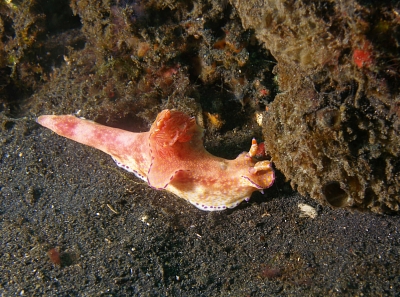
Bill,
Following on from my last message [#20945], here is another of Ceratosoma tenue. The animals were also slowly moving on black sandy bottom and rubble. They don't seem to be feeding and I couldn't spot any sponges. Maybe you can?
Locality: Lembeh Straight, N.E. Sulawesi, 10 metres, Indonesia, Celebes sea, 12 August 2007, Sandy bottom. Length: 100 mms. Photographer: Kamal El Tawil.
Kind regards,
Kamal El Tawil
www.coralworld.net
kamal@coralworld.net
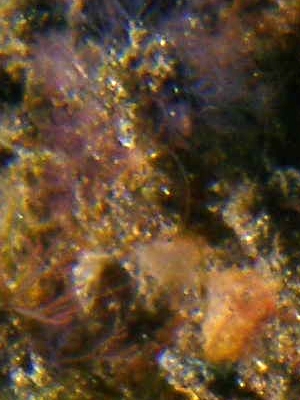
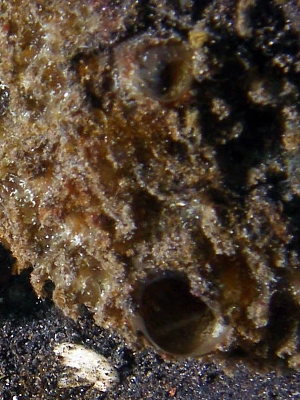
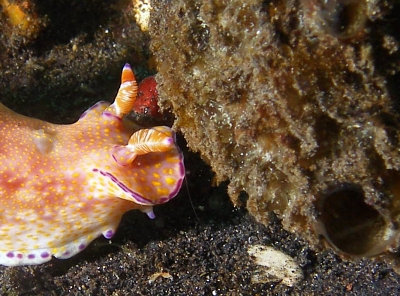
Dear Kamal,
Firstly, this is Ceratosoma gracillimum. In this species there is no mantle edge along the sides between the head and the large gill lobes. In C. tenue there is a small lobe on each side between the head and the gills. As in your last message, the lumpy mass is definitely sponge. In the photo alongside you can see a large hole [or siphon] which sponges use to suck fresh seawater into the colony. It is possible there is more than one sponge present. I have also added a close-up - not very clear I'm afraid - showing a purplish pink patch which is almost certainly the dysideid sponge Euryspongia. Interestingly, Ken Tucker's message [#20282] gives good evidence that this species feeds on a species of Euryspongia. Before this the only information we had on feeding in this species was indirect evidence from the presence of sesquiterpenoid molecules in chemical assays (Rudman & Bergquist, 2007).
-
Rudman, W.B. & Bergquist, P.R. (2007) A Review of feeding specificity in the sponge-feeding Chromodorididae (Nudibranchia: Mollusca). Molluscan Research, 27(2): 60-88
Best wishes,
Bill Rudman
Ceratosoma gracillimum from Singapore
September 3, 2007
From: Lior Harari
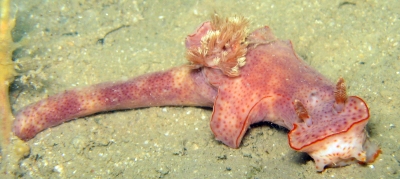
Dear Bill,
Could identify this nudi?
Locality: Pulau Hantu, 10 meters, Singapore, South China Sea, 26 August 2007, Silty . Length: 10 cm. Photographer: Lior Harari.
Thanks,
Lior Harari
hararilior@yahoo.com
Harari, L., 2007 (Sep 3) Ceratosoma gracillimum from Singapore. [Message in] Sea Slug Forum. Australian Museum, Sydney. Available from http://www.seaslugforum.net/find/20600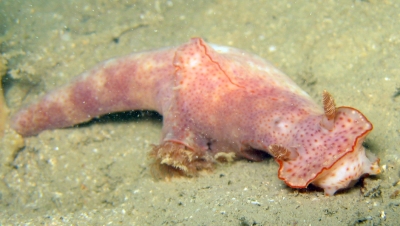
Dear Lior,
I am pretty sure this is Ceratosoma gracillimum. However is doesn't look very healthy
Best wishes,
Bill Rudman
Possible juvenile Ceratosoma?
August 20, 2007
From: Charles Raabe
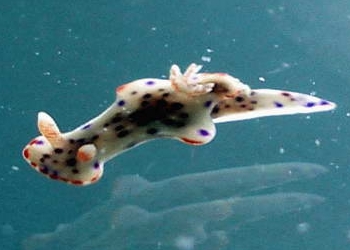
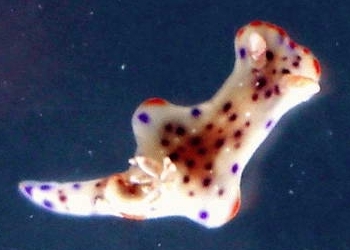
Was unable to match this nudibranch and am curious as to what it could be. Thanks.
Locality: Mactan Island, Philippines, 25 feet, Camotes Sea, 15 August 2007, Crest of reef wall. Length: 5 mm. Photographer: Charles Raabe.
Charles Raabe
charlesr1958@pacific.net.ph
Raabe,C.A., 2007 (Aug 20) Possible juvenile Ceratosoma?. [Message in] Sea Slug Forum. Australian Museum, Sydney. Available from http://www.seaslugforum.net/find/20488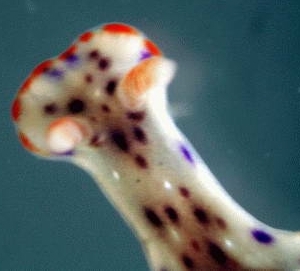
Dear Chuck,
It's definitely a juvenile Ceratosoma, and could be either Ceratosoma gracillimum or C. trilobatum. The complete absence of a mantle ridge between the frontal lobe and the gill lobes suggest it is C. gracillimum. I have never seen a specimen quite this small before and am amazed just how well-developed its body shape is.
I suggested some years ago that in Ceratosoma, the mantle glands filled with noxious chemicals were concentrated in specific 'sacificial' parts of the body, so that fish would be able to taste a non-essential part of the body and learn that the slug was distasteful without killing it. The most obvious parts are the characteristic dorsal horn and the lateral mantle lobes. In one species with a stumpy dorsal horn,Ceratosoma brevicaudatum, the dorsal horn is often bright red [see Fact Sheet photos], and acts as a lure attracting predators to the largest concentration of mantle glands. Recently a group of natural products chemists (Mollo et al, 2005) have shown the dorsal horn and lateral lobes of some tropical species are precisely where the anti-feedant chemicals are stored.
Your photo is very interesting becasue it shows bright red markings around the anterior mantle lobe and along the edge of the two lateral lobes precisely where the anti-feedant chemcials are stored, suggesting again that the colours are there to attract potential predators to the most distasteful part of the body. I can't see clearly, but it looks like there are red marks on the dorsal horn as well.
-
Mollo, E., Gavagnin, M., Carbone, M., Guo, Y.-W. & Cimino, G. (2005) Chemical studies on Indopacific Ceratosoma nudibranchs illuminate the protective role of the dorsal horn. Chemoecology, 15: 31-36.
-
Rudman, W.B. (1991) Purpose in Pattern: the evolution of colour in chromodorid nudibranchs. Journal of Molluscan Studies, 57, (T.E. Thompson Memorial Issue): 5-21.
Best wishes,
Bill Rudman
Re: Ceratosoma gracillimum feeding? from Lembeh
July 23, 2007
From: Ken Tucker
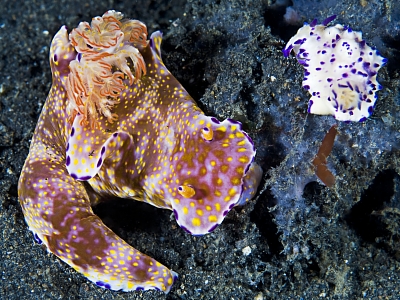
Concerning message #20164:
I thought perhaps someone might be able to glean some info from this photo of Ceratosoma tenue.
Locality: North Sulawesi, Lembeh Strait, 10 metres, Indonesia, Celebes Sea, 9 Nov 2005. Length: 7 cm. Photographer: Ken Tucker.
Ken Tucker
ken@kilili.com
Tucker, K. C., 2007 (Jul 23) Re: Ceratosoma gracillimum feeding? from Lembeh. [Message in] Sea Slug Forum. Australian Museum, Sydney. Available from http://www.seaslugforum.net/find/20282
Dear Ken,
This is an very useful find. Although even in the high resolution copy of your photo, I can't make out enough detail in the blue sponge to make a positive identification of the sponge, the presence of Mexichromis multituberculata on the sponge as well is a very large clue. If you look at Richard Swann's recent message [#20194], and my comments, you will see that Mexichromis multituberculata feeds on a species of the dysideid genus Euryspongia, and it is very similar in shape and morphology to the blue sponge in your photo, so I think we can be fairly sure that this Ceratosoma feeds on Euryspongia.
As to the identity of the Ceratosoma, the lack of secondary mantle lobes on eacxh side between the gills and the rhinophores suggest this is C. gracillimum rather than C. tenue. This is a valuable bit of information, as it confirms the only information we have on this species, which is from the sponge metabolites found in its mantle glands which suggest it feeds on a dysideid sponge. It's certainly possible the sponge C. tenue is feeding on in the message you refer to above [# 20164], is also Euryspongia, but I'm afraid we don't have a Mexichromis on hand to give us a clue.
Best wishes,
Bill Rudman
Colour variations of Ceratosoma trilobatum?
December 22, 2006
From: Mike Krampf
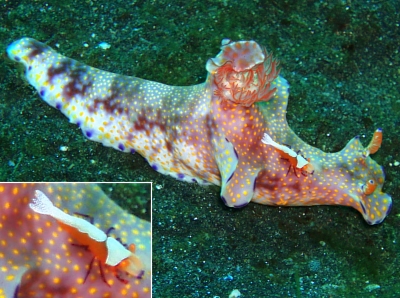
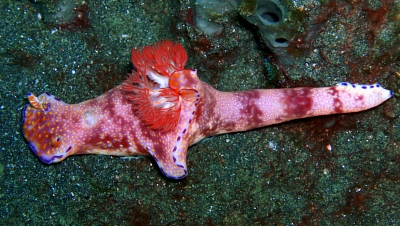
I thought I'd share these pics showing three different colour variations of Ceratosoma trilobatum. All these pics were taken in Lembeh Strait.
Locality: Lembeh Strait, 45 ft, Indonesia, Celebes Sea, 28 October 2006, Sandy bottom. Length: 8 mm. Photographer: Mike Krampf.
Mike
mtkrampf@yahoo.com
Krampf, M., 2006 (Dec 22) Colour variations of Ceratosoma trilobatum?. [Message in] Sea Slug Forum. Australian Museum, Sydney. Available from http://www.seaslugforum.net/find/18773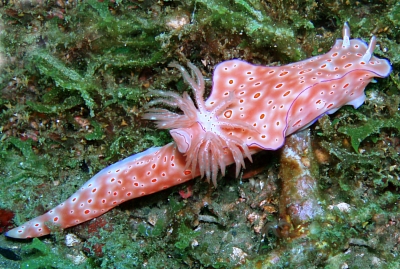
Dear Mike,
Thanks for these photos which show not only colour variation but species differences as well. The upper two animals are Ceratosoma gracillimum which can be distinguished externally by the complete absence of the mantle edge between the head and the well-developed lateral lobes on each side. The animal in the lower photo is indeed C. trilobatum. In it you can see the mantle edge, edged in purple, between the head and the lateral lobes. Both species have a similar range of colour variations, as does C. tenue, but they differ from each other externally by the lack of a mantle edge in C. gracillimum and the extra pair of small lateral lobes in C. tenue.
One other point which might be of interest. In the middle photo there is a bit of a grey sponge visible in the top of the photo. You wouldn't by chance have a photo of Ceratosoma, on or eating that sponge would you? It looks as though it could belong to a family of sponges which I think Ceratosoma feeds on. For that matter, if you haven't already been harassed by me for photos of slugs 'doing things', if you have any photos of Ceratosoma feeding or taking what looks like more than a passing interest on a possible food item, please send them in. I consider one success out of 20 'possibles' to be reasonable odds so don't worry if you are not sure.
Best wishes,
Bill Rudman
Ceratosoma gracillimum? from Komodo Ids
December 11, 2003
From: Teresa Zubi
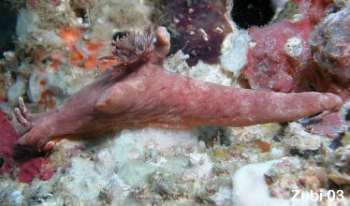
I found a pair of Ceratosoma nudibranchs in the Komodo islands, Indonesia. I know this kind of nudibranch from other dive sites in Indonesia such as Lembeh, but this one is a light pink with no visible spots. Is it a Ceratosoma gracillimum?
Teresa Zubi
webmaster@starfish.ch
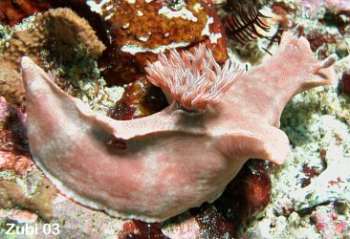
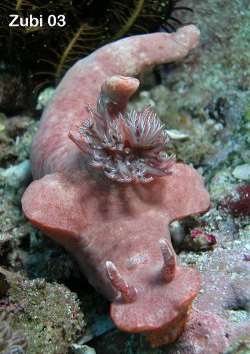
Dear Teresa,
Colour is not a good character in species of Ceratosoma most species being very variable in colour. Shape is very important. In the upper and lower right photos you can see that there is no mantle ridge between the head and the lateral mantle lobes alongside the gills. This is unique to this species. If you look at photos of C. trilobatum you will see a distinctive ridge on each side from the lateral lobes to the head.
The animal in your lower left photo has obviously been damaged. It has lost the medio-dorsal horn behind the gills, and there is a prominent ridge on each side running back from the gills. I suspect something has eaten off the horn. In species of Ceratosoma, the horn stores noxious chemicals the animal obtains from the sponges it feeds on. I have suggested elsewhere that this horn is a defensive lure attracting predators to bite the most distasteful, and otherwise useless, part of its body so deterring them from eating a more vital part of the body.
Best wishes
Bill Rudman
Ceratosoma gracillimum from north Sulawesi
December 10, 2003
From: Francis & Pirjo Pellet
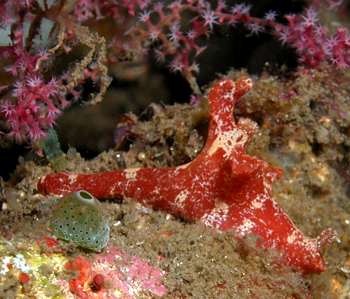
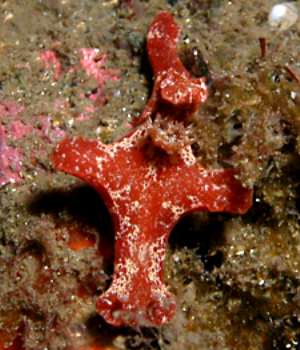
Dear Bill,
We found this Ceratosoma during a night-dive. It was on the gorgonian you can see in the upper picture. Is this Ceratosoma gracillimum?
Indonesia, Lembeh Straits
dive site: Nudi Falls (night-dive)
length: 80 mm
depth: 12 m
date: 27 September 2003
Thanks for the identification .
Francis & Pirjo Pellet
pirjo.pellet@free.fr
Pellet, F. & Pellet, P., 2003 (Dec 10) Ceratosoma gracillimum from north Sulawesi. [Message in] Sea Slug Forum. Australian Museum, Sydney. Available from http://www.seaslugforum.net/find/11558Dear Francis & Pirjo,
This certainly looks like Ceratosoma gracillimum. It tends to have longer but more quadrangular shaped lobes than C. trilobatum and lacks any sign of a mantle edge between the head and the lateral lobes.
Best wishes
Bill Rudman
Ceratosoma gracillimum from the Solomon Ids
November 29, 2001
From: Bruce Potter
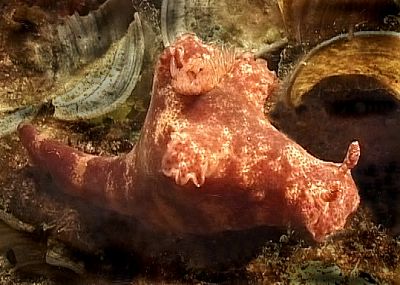
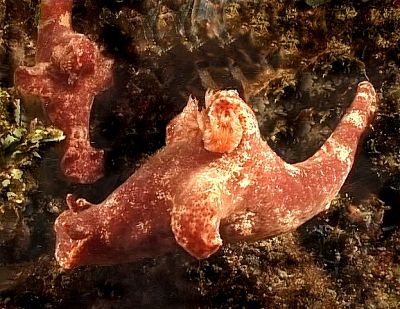
Bill,
I found three of these Ceratosoma last night (19 November) on a dive site just on the outskirts of Honiara, Solomon Islands.
They were at about 12 meters, and the largest of the three would have been about 10mm long. Is this Ceratasoma gracillimum?
What interests me is that I have been diving in Solomon Islands for 12 years, and the past three on this particular site nearly every week, and I have never seen this Ceratasoma before, then I suddenly find three, all together. How did they find each other, or is it possible that they all hatched out at the same time, and have stayed together all the time?
Regards
Bruce Potter.
bruce.potter@adventist.org.sb
Potter, B., 2001 (Nov 29) Ceratosoma gracillimum from the Solomon Ids. [Message in] Sea Slug Forum. Australian Museum, Sydney. Available from http://www.seaslugforum.net/find/5706Dear Bruce,
Yes this is C. gracillimum. Why are they together and why haven't you seen it before? We still have much to learn about nudibranch population dynamics. While it has been possible to study some temperate water species in considerable detail, because they have fairly large 'permanent' populations, this has not proved so easy with species which are not so common, or feed on animals which are themselves fairly sparsely distributed, which is the case with many tropical animals.
If you consider the lottery they participate in. If their egg mass survives, they hatch out as planktonic larvae and after some days or weeks drifting in the plankton, they then have to find the right sponge (or other appropriate food) to settle on and grow to adulthood. Keep in mind that the sponge has has also gone through a similar planktonic larval stage. This certainly explains why a species can suddenly arrive at a particular spot, such as your dive site, even though it has been absent from there for many years. Apparently this year the sponge larvae settled, and a while later the nudibranch larvae drifted past and sensed its presence. How come three Ceratosoma settled together? I guess that is one of life's little mysteries. I find it difficult to believe that a group of C. gracillimum larvae stuck together during their planktonic life, but until someone devises a way to study this, it must remain a possibility. However it happened, clearly a number of larvae sensed an appropriate sponge colony, or perhaps a 'garden' of many sponges of the same species, and settles out of the plankton. Again there are very few long-term studies of tropical species but the little evidence we have suggests they stay near their food colonies, which would explain why you found three together. This is just conjecture. It would be nice to have some more long-term studies of tropical species, but such work is note easy.
Best wishes,
Bill Rudman
Ceratosoma gracillimum from Japan
September 19, 2000
From: Atsushi Ono
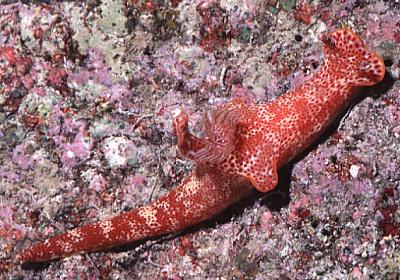
Dear Bill,
Thank you for ID of Risbecia tryoni .
Now I have found a big chromodorid which I think is Ceratosoma gracillimum.
Is this correct?
About 80mm long, at 15m in a bay of Kerama Is. near Okinawa in Japan.
Sincerely,
Atsushi Ono
ononini@cosmos.ne.jp
Ono , A., 2000 (Sep 19) Ceratosoma gracillimum from Japan. [Message in] Sea Slug Forum. Australian Museum, Sydney. Available from http://www.seaslugforum.net/find/3036Dear Atsushi,
Yes it certainly looks like C. gracillimum. I was surprised to find I hadn't prepared a page on this species, so I have added one.
Best wishes,
Bill Rudman.
